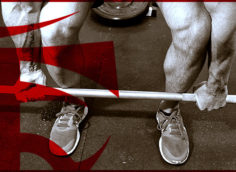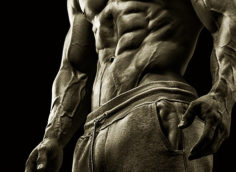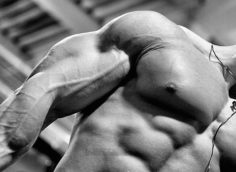Training Effects for Bodybuilding
What training variables are the most important to consider in bodybuilding? Is it body fat? What about protein intake? Flexibility? Training age? Equipment? Drugs? Lifting technique?
Buzzzz... Nope, sorry. All of these have their place but none matter most. The answer is maximal-strength, dynamic strength and work-capacity. In other words, setting new personal records and then training with a new, higher percentage of that record for more sets and reps.
Let's break it down.
Absolute Strength – Maximum Force
This is the force generated by the momentary activation of all available motor units from the motor unit pool and its associated muscle fibers. Hardcore lifters note that this is valid only under the psychological rigors of competition. (Showing off in front of a few hotties at the gym qualifies in my mind.)
The effect of a higher absolute strength is to transfer to a greater load used for more reps (dynamic strength-endurance / bodybuilding method). The development of absolute strength is attained with infrequent yet consistent attempts at 1-3 rep maximum lifts to failure.
Dynamic Strength – Endurance (Bodybuilding Method)
As mentioned, this is the specific ability to execute repetitive and sufficient muscular tension and multiple repeated efforts using a relatively slow speed of movement. It's a function or percentage of both absolute strength and work capacity. The caveat here is that if the resistance becomes too heavy (greater than 80% maximum), then the bodybuilding effect is compromised and shifted toward absolute strength.
Work Capacity
This is the general ability to produce work of varying intensities and durations using the appropriate energy systems. In bodybuilding, these energy systems are predominantly the ATP-CP and lactic acid energy systems lasting from 1 to 150 seconds.
Now that you know the three most influential components of bodybuilding, let's see how to best put them into a program.
Overreach then Super-Compensate!
Every conversation I've ever had with competitive bodybuilders over the last fifteen years always leads down the mysterious path of "instinctive training methods." This is defined loosely as doing whatever you feel or are motivated to do that training session, with seemingly little rhyme or reason other than "it just feels right."
I've always speculated whether this method actually has an exercise science basis or if it was merely a reflection of the anabolics really doing the work. The answer I found may shock you. A recent study by some highly respected researchers in the Journal of Strength and Conditioning Research (May 2003, Vol. 17 No. 2, by Ratamess, Kramer, Volek, Hakkinen et al) dialed me into an explanation.
The study used a planned over-reaching program. A slight over-training period was followed by a higher intensity strength training phase and ended with a tapered unloading. The program resulted in outstanding strength gains in both the experimental and control subjects over a few weeks. More importantly, it revealed a clear training effect over time in the general adaptation model.
The cycle was:
• Two week over-reaching phase (bodybuilding method)
• Two week neural adaptation phase (maximal strength)
• Two week recovery or super compensation phase (muscle growth)
The initial shock period ended with a 5% strength drop-off, yet prepared the trainees for a slingshot-like increase in strength over the next phase. The original purpose of the study was to test nutritional supplements that would offset the initial over-reaching phase and foster faster recovery. They concluded that any nutritional (and I'll add chemical) interventions that increase nitrogen retention would curtail the initial drop-off in strength, thereby speeding up the adaptation process by a week or so.
The Point
Regardless of the specific program parameters used, following this shock / adapt / gain cycle, will result in the fastest gains possible in both size and strength. Now, of course, subtle adjustments must be made. The basis for those adjustments are prioritized by recovery ability, chemical interventions and the "other" less important variables discussed in paragraph one.
So that T-Nation readers can experience this process first hand, I've written a posterior chain program (lower back, hamstrings and glutes) that includes all three phases and reliably delivers a whopping 15 to 30 pound increase in maximum strength and up to a half-inch on the legs.
The reason I chose this program is simple: An underdeveloped posterior chain, as found in the majority of lifters, represents 8 to 10 pounds of potential muscle mass gain, per leg. So if you want to add some muscular pounds, this is the surefire way to do it!
Nutritional Recommendations
Daily:
2 grams of quality protein per pound of bodyweight
50-70 grams smart fats
Training days:
1 scoop Surge plus additional 10 grams l-glutamine, 5 grams branch chain amino acids and 3 grams l-arginine three times per day
Week 1-2: Bodybuilding / Over-Reaching Method
Shock Phase I – Moderate Tension, Excessive Volume
Day 1 and day 2 are to be repeated twice per week. Day 3 is to be performed once per week on the day of the trainee's choice. Using the same rep and set scheme, two upper body days of the trainee's choice are to be alternated for a total of five training days per week.
In this phase, a constant weight is used and you're given incomplete recovery time. In order to successfully complete all the sets and reps, start with a weight that you can maximally lift 12 times on set one. Each subsequent set will demand more effort. By set four, you should be at maximal effort.
By the end of week two, most trainees will notice a drop-off in strength as compared to the preceding workout. If no drop-off occurs, then a third week of the shock phase may be added. This is to ensure a slight overtraining and set up the "sling shot effect" in the weeks to come.
Day 1
A) Leg press machine calf raise – Using any angle leg press machine, position the balls of the feet on the bottom edge of the leg press platform. (Keep safety rails in locked position at all times.) Press the platform forward until the knees are in a soft lockout. Next, using the balls of the feet and not the toes, extend the ankles and press the load fully. Lower the load by flexing the ankles and stretching the Achilles tendon.
Sets: 10
Reps: 10
Tempo: 201
Rest: 60 seconds
B) Romanian deadlift – This exercise is designed to strengthen the medial leg muscles along with teaching the proper initiation of the posterior chain into compound movements.
The bar is grasped with a clean, shoulder-width grip. Use a wider than hip-width stance, elbows extended, knees slightly bent. Start the eccentric (lowering) movement with the bar against the body. The bar is descended to just below the knees with the backwards push of the hips and buttocks. Note: This eccentric phase should take up to 4 seconds and the center of mass should be positioned on the heels in the bottom position.
Sets: 6
Reps: 6
Tempo: 40X (pull the bar up with maximal acceleration)
Rest: 90 seconds
 |
C) Seated single leg curls – The seated leg curl loads the strength curve at the end range of motion (closer to the glutes than its lying curl cousin). Align the joints of the machine with your knee and ankle joints. Using one leg, point the toes forward and keep the foot centered at all times. Flex the knee joint toward the glutes before extending it back to its original position.
Sets: 6
Reps: 6
Tempo: 201
Rest: 90 seconds
 |
D) Standing leg curls – To isolate the knee flexor muscles you must ensure that your hips aren't extending. This is due to the fact that the hams can perform a dual function of hip extension and knee flexion. Do this by placing the stabilizing leg and hip in front of the active leg and pressed firmly against the hip pad. Using one leg, keep the ankle neutral (not pointed) and rotate the toes outward 20º. Flex the knee joint toward the glutes before extending it back to its original position.
Sets: 6
Reps: 10
Tempo: 401
Rest: 90 seconds
 |
E) Weighted twisting crunches – Holding a small weight behind your head, lift your mid and upper back a couple inches off the floor with the contraction of your abs. Twist all the way to one side and then the other while maintaining the spinal flexion.
Sets: 4
Reps: 12
Tempo: 201
Rest: 60 seconds
Day 2
A) Low box squat – Place a box or bench with a height of 8 to 15" in a squat rack or power rack. Grasp a bar with a wider than shoulder-width grip and place the bar high along the upper traps. Rotate the elbows forward directly underneath the bar.
Un-rack the bar and stand with the feet narrower than shoulder-width apart, feet turned out 20º. Lower the bar by flexing the knees, hips and ankles until you sit on the low box. Allow your weight to transfer away from the feet and hips toward your glutes, yet maintain a lower back arch at all times. To lift the load, with your knees pressed outward, transfer your weight toward your feet and extend the hips, knees and ankles to the upright position.
Sets: 6
Reps: 6
Tempo: 30X (push the bar up with maximal acceleration)
Rest: 60 seconds
 |
B) Vertical leg press (a 45º leg press may be substituted if necessary) – Place your feet much wider than shoulder-width apart, feet turned out 20º. To lift the load, extend the hips, knees and ankles to a soft lockout position. Lower by reversing this motion. Note: Be very careful not to bounce with the knees against the ribs as this can lead to stress fractures.
Sets: 10
Reps: 10
Tempo: 30X
Rest: 60 seconds
 |
C) Lunge – Grasp a bar with a wider than shoulder-width grip and place it high along the upper traps. Rotate the elbows forward directly underneath the bar. Now un-rack the bar and stand with the feet narrower than shoulder-width apart. Step forward, heel to toe, as far as possible with the right leg, then bend the knee until the upper thigh is parallel to the floor. Keep the left leg as straight as possible. Thrust the right leg back to the starting position. Alternate sides.
Sets: 6
Reps: 6
Tempo: 20X
Rest: 60 seconds
D) Mule kicks (cable hip extensions) – This exercise trashes the knee flexion and hip extension functions of the hamstrings, along with being a great glute developer. Attach an ankle strap on the low cable machine and attach the right leg to the strap. Facing toward the machine, flex the right knee 45º and then fully extend the hips. Be careful not to twist the torso or pelvis. Use light weight and super strict form.
Sets: 6
Reps: 10
Tempo: 30X
Rest: 60 seconds
 |
E) Hanging leg raises – Begin by hanging from a chin-up bar, hands spaced wider than shoulder-width. First, contract the inner muscle unit of the abdominals by sucking in the belly plus adding a reverse pelvic tilt. Next, while maintaining abdominal tension, flex the hips (knees straight) and pull into the abdomen. Lower by extending the hips.
Sets: 4
Reps: 12
Tempo: 30X
Rest: 60 seconds
Day 3 (Anaerobic Work Capacity)
A1) Romanian deadlift medicine ball toss and catch – Set up with a wider than hip-width stance, elbows extended, knees slightly bent. The medicine ball is lowered between the knees with the backwards push of the hips and buttocks. The center of mass should be positioned on the heels in the bottom position. Next, explosively extend the spine and flex the shoulders to throw the ball overhead. Catch and repeat. Go for ball height! Note: A 12-15 pound medicine ball should be used.
Sets: 10
Reps: 10
Rest: 90 seconds
 |
 |
A2) Jump Squat – Load a bar with 25% of your 1RM (rep max) back squat. Keep the bar firmly planted on your traps as you perform maximum continuous vertical jumps. Don't stop between reps as this will negate the plyometric effect. Go for hang time!
Sets: 10
Reps: 10
Rest: 90 seconds
Week 3-4 – Phase II Higher Tension, Moderate Volume
Day 1 and day 2 are to be repeated twice per week. Using the same rep and set scheme, two upper body days of the trainee's choice are to be alternated for a total of four training days per week.
In this phase an undulating set-load is used to enhance neural drive and tension time. You'll be given near-complete recovery time. After a progressive warm-up, use a weight that you maximally lift for set 1. Providing you put forth a maximal effort, each subsequent set should increase the load by 3-5%.
By the end of week two, most trainees will notice a 5 to 15 pound increase in strength as compared to the preceding workout. If no increase occurs then a third week of this phase must be added.
Day 1
A) Barbell squat (maximal strength method)
Sets: 5
Reps per set: 5,4,3,2,1 (go for a personal record for a max single)
Tempo: 30X
Rest: 180-240 seconds
B) Lying single leg curl – Lie belly down on a leg curl machine. Align the joints of the machine with your knee and ankle joints. Point the toes forward and rotate the feet out 20º. Flex the knee joints into the glutes before slowly extending them back to their original position.
Sets: 6
Reps per set: Week 1: 8,6,4,4,6,8 – Week 2: 6,4,2,2,4,6
Tempo: 30X
Rest: 120 seconds
 |
C) Standing calf raise – Using a standing calf machine, place the balls of the feet shoulder-width apart. Use a slight bend in the knees. Extend the ankles to raise the load. Lower the load by flexing the ankles.
Sets: 6
Reps per set: Week 1: 8,6,4,4,6,8 – Week 2: 6,4,2,2,4,6
Tempo: 30X
Rest: 120 seconds
D) Reverse crunch on slant board – Start on your back, knees flexed, and reverse tilt your pelvis to facilitate a flat back (under the belly button). Anchor your upper body by grasping a fixed object behind your head. From there, flex the hips and pull the knees into the chest. Next, lower your legs until you can no longer retain the flat back position and your lower back arches.
Sets: 6
Reps: 10
Tempo: 30X
Rest: 120 seconds
 |
Day 2
A) Deadlift – Grasp the bar with a clean-width pronated grip, elbows locked, feet shoulder-width, toed out slightly. Using an arched back, lift the bar from the platform with an extension of the knees, hips and ankles. The bar is in constant contact with the body. Lower the bar by scraping it along the body to its resting position. Keep the chin and neck retracted and head in a neutral position. Tip: Use lifting straps.
Sets: 5
Reps per set: 5,4,3,2,1 (go for a personal record for a max single)
Tempo: 30X
Rest: 180-240 seconds
B) Lying single leg curl
Sets: 6
Reps per set: Week 1: 7,5,3,3,5,7 – Week 2: 8,6,4,4,,6,8
Tempo: 30X
Rest: 120 seconds
C) Standing calf raise
Sets: 6
Reps per set: Week 1: 7,5,3,3,5,7 – Week 2: 8,6,4,4,6,8
Tempo: 30X
Rest: 120 seconds
D) High cable abdominal crunches – Attach a rope to a pulldown machine. Position the knee restraints of the machine at its top position. Facing away from the machine, grasp the rope with both hands and pull it down around the neck so that your hands rest on your chest. Next, flex the torso with a contraction of the abs, pulling down into the hips. Reverse this by extending the spine fully.
Sets: 6
Reps: 10
Tempo: 20X
Rest: 120 seconds
 |
Week 5-6 – Unloading Phase III: Moderate Tension, Increasing Training Density
Day 1 and 2 are to be performed once per week. Using the same rep and set scheme, one upper body day of the trainee's choice is to be alternated for a total of three training days per week.
In this phase an incomplete rest interval is used so that super-storage of glycogen and energy phosphates is forced. This increases non-contractile protein hypertrophy. Decreasing weight must be used to match the 10% drop-off due to increasing lactate levels.
Use a weight you maximally lift 12 times on set 1. Providing you put forth a maximal effort, each subsequent set should decrease the load by 10% in order to maintain 12 reps. Providing that calories and protein are increased to 25% above maintenance, most trainees will notice a measurable size increase by the end of week two. If no increase occurs, then carbohydrates along with insulin sensitivity aides should be increased and a third week of this phase should be added.
Day 1
A) Leg press machine calf raise
Sets: 3
Reps: 12
Tempo: 303
Rest: 60 seconds
B) Romanian deadlift
Sets: 3
Reps: 12
Tempo: 303
Rest: 60 seconds
C) Seated leg curls (two leg)
Sets: 3
Reps: 8
Tempo: 303
Rest: 60 seconds
D) Standing calf raise (two leg)
Sets: 3
Reps: 10
Tempo: 303
Rest: 60 seconds
E) Weighted twisting crunches
Sets: 3
Reps: 12
Tempo: 303
Rest: 60 seconds
Day 2
A) Vertical leg press
Sets: 3
Reps: 12
Tempo: 303
Rest: 60 seconds
B) Lunge
Sets: 3
Reps: 12
Tempo: 303
Rest: 60 seconds
C) Mule kicks – Use light weight for form
Sets: 3
Reps: 12
Tempo: 303
Rest: 90 seconds
D) Hanging leg raises
Sets: 3
Reps: 12
Tempo: 303
Rest: 90 seconds
Week 6
Use the same exercise selection, order and volume as above. Increase the reps to 12 across the board and decrease the rest time to 45 seconds.
Conclusion
If you follow this plan closely and stick to the dietary guidelines, then you could add up to twenty pounds of mass and build a powerful posterior chain. Try it and keep me updated on your progress!




